|
|
|
Sort Order |
|
|
|
Items / Page
|
|
|
|
|
|
|
| Srl | Item |
| 1 |
ID:
132561
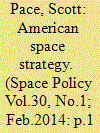

|
|
|
|
|
| Publication |
2014.
|
| Summary/Abstract |
This Viewpoint addresses American space strategy and the choices that lie before US space practitioners. Space activities today play critical roles in U.S. national security, economic growth, and scientific achievements. Satellite communications link the world. The Global Positioning System (GPS) is an integral part of several critical infrastructures, and enables functions ranging from survey and construction, to farming, finance, and air traffic management e not to mention US military forces worldwide. Less well understood is how the GPS time signal provides a global time base for encrypted communications e including point-of-sale transactions with credit or debit cards. Without GPS, much of today's economy would come to a halt. Beyond the Earth, we have rovers on the surface of Mars, and a probe that has left the solar system. The International Space Station represents a unique collaborative
partnership between the United States, Europe, Canada, Japan, and Russia. Spacefaring states are concerned with the long-term sustainability and security of space activities as a result of increasing orbital debris and the proliferation of space capabilities of new national entrants, some of them potential adversaries.
|
|
|
|
|
|
|
|
|
|
|
|
|
|
|
|
| 2 |
ID:
139176


|
|
|
|
|
| Summary/Abstract |
Interest in the exploration of the Moon, much like its phases, has waxed and waned since the beginning of space exploration. The quest for the Moon was an integral part of the space race between the Soviets and the Americans in the 1960s and 1970s, which resulted in a total of 65 missions, including the six manned missions by the US, before they both shifted focus to manned space stations and missions to Mars. Strategically or militarily, the Moon did not offer them much advantage. Scientifically, there was not much that was expected to be revealed after the first few missions. Economically, there was no great rationale for continuing a high cost programme from which few commercial gains could be expected at the time. Mars offered more opportunities for national prestige, scientific discovery as well as mining prospects. In the next few decades, although there were periodic statements about the potential of lunar exploration, these did not translate into actual efforts by any space-faring nation.
|
|
|
|
|
|
|
|
|
|
|
|
|
|
|
|
| 3 |
ID:
079562
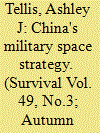

|
|
|
| 4 |
ID:
141027
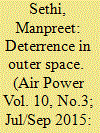

|
|
|
| 5 |
ID:
101223
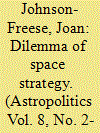

|
|
|
| 6 |
ID:
132565
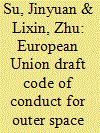

|
|
|
|
|
| Publication |
2014.
|
| Summary/Abstract |
The European Union draft Code of Conduct for outer space activities is one of the primary international initiatives, that are currently active, to enhance the safety, security and sustainability of outer space activities. Although the spirit underlying the instrument is commonly shared by space-faring countries, substantial disagreement exists among States as to some of its core provisions. This article proposes that the Code of Conduct should make a clear distinction between commercial activities and military activities, and adopt more balanced measures on the restriction of military activities in outer space.
|
|
|
|
|
|
|
|
|
|
|
|
|
|
|
|
| 7 |
ID:
111626
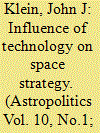

|
|
|
|
|
| Publication |
2012.
|
| Summary/Abstract |
The influence of technology on the conduct of warfare and the development of strategy is still largely misunderstood. This confusion also holds true regarding technology's influence on space warfare and the development of space strategy. Judging from history, we can expect that advances in space-related technology will be used in ways commensurate with the current paradigm, especially with respect to military operations. Therefore, space operations will probably play supporting roles to operations on land, at sea, and in the air, at least in the near term. It will likely be some time until the strategic advantages of space-based or space-enabled operations are fully appreciated and effectively employed. Additionally, the historical theory and principles of general warfare remain valid, even when considering military operations in space. While advances in space-related technology or space-based weaponry will not change the fundamental nature of warfare, they are expected to change warfare's conduct and character. Through a better understanding of technology's influence on military operations, it is possible to develop a more complete theory and more fully developed strategic principles of space warfare.
|
|
|
|
|
|
|
|
|
|
|
|
|
|
|
|
| 8 |
ID:
132563
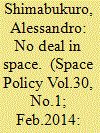

|
|
|
|
|
| Publication |
2014.
|
| Summary/Abstract |
Space systems are essential to the global economy and security. The possibility of disruptions arising from competition between the United States and China through the testing and deployment of weapons in space has led to concerns over an incipient space arms race that would threaten satellites, leading to international calls for a space arms control treaty. The paper presents a rationalist theory analysis on the lack of progress in establishing such a treaty, identifying the United States' position of primacy in the global order and its preeminence in space as a primary cause.
|
|
|
|
|
|
|
|
|
|
|
|
|
|
|
|
| 9 |
ID:
101221
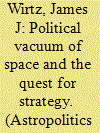

|
|
|
| 10 |
ID:
132718


|
|
|
|
|
| Publication |
2014.
|
| Summary/Abstract |
Despite a rich legacy of impressive technological accomplishments, the government acquisition of advanced space systems is increasingly synonymous with schedule slips and cost overruns. Program reviews have suggested that investing more in centralized and strategic research and development outside particular programs will reduce technical uncertainties and improve cost and schedule outcomes. This paper suggests roles for a centralized technology office by examining the methods available in the literature for managing portfolios of research projects.
In particular, the paper answers three questions. Firstly, it examines the key features that characterize the space agencies' innovation context compared to the private sector where most of the portfolio literature is founded. Secondly, it summarizes the advantages and disadvantages of the models in the literature. Finally, the paper addresses how innovation decision making should be structured within agencies in order to achieve the best results. The paper concludes that an executive level technology office is best placed to act as an enabler, rather than an absolute decision maker. Such an office would not replace decision making at the technical manager level, but would provide overall strategic direction and guidance within which technical managers can make decisions about project innovation.
|
|
|
|
|
|
|
|
|
|
|
|
|
|
|
|
| 11 |
ID:
132717


|
|
|
|
|
| Publication |
2014.
|
| Summary/Abstract |
In 2009 President Obama proposed a budget for the National Aeronautics and Space Administration (NASA) that canceled the Constellation program and included the development of commercial crew transportation systems into low Earth orbit. This significant move to shift human spaceflight into the private sector sparked political debate, but much of the discourse has focused on impacts to "safety." Although no one disputes the importance of keeping astronauts safe, strategies for defining safety reveal contrasting visions for the space program and opposing values regarding the privatization of U.S. space exploration. In other words, the debate over commercial control has largely become encoded in arguments over safety. Specifically, proponents of using commercial options for transporting astronauts to the International Space Station (ISS) argue that commercial vehicles would be safe for astronauts, while proponents of NASA control argue that commercial vehicles would be unsafe, or at least not as safe as NASA vehicles. The cost of the spaceflight program, the technical requirements for designing a vehicle, the track record of the launch vehicle, and the experience of the launch provider are all incorporated into what defines safety in human spaceflight. This paper analyzes these contested criteria through conceptual lenses provided by fields of science and technology policy (STP) and science, technology, and society (STS). We ultimately contend that these differences in definition result not merely from ambiguous understandings of safety, but from intentional and strategic choices guided by normative positions on the commercialization of human spaceflight. The debate over safety is better considered a proxy debate for the partisan preferences embedded within the dispute over public or private spaceflight.
|
|
|
|
|
|
|
|
|
|
|
|
|
|
|
|
| 12 |
ID:
114244
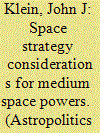

|
|
|
|
|
| Publication |
2012.
|
| Summary/Abstract |
When compared to the strategies of superpowers, the strategies of medium powers are often different due to a medium power's frequent desire to act independently while being comparatively more constrained by available material and fiscal resources. For this reason, the space strategy of medium space powers is different from either emerging or super space powers. The fundamental purpose of any medium space power's space strategy should be to ensure access to and use of celestial lines of communication to support national objectives, whether during peace or conflict. When deciding how best to protect its interests in space, a medium space power will have a variety of non-military and military options. These options may include diplomacy, economic measures, benign defensive technologies, or the employment of offensive actions in space. Though the debate surrounding the weaponization of space continues, it is worth noting that the application of the inherent right of self-defense provides the authority for states to protect their assets or interests when attacked, and this protection may include the use of force in space, if needed.
|
|
|
|
|
|
|
|
|
|
|
|
|
|
|
|
| 13 |
ID:
052094
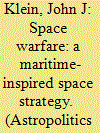

|
|
|
| 14 |
ID:
100636
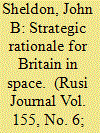

|
|
|
|
|
| Publication |
2010.
|
| Summary/Abstract |
Not only will space become an even more important domain of military capability in the future, it will be an increasingly crowded arena. Britain's space strategy has lagged behind those of its allies, with the UK reliant on foreign capability for mission-critical tasks such as satellite imagery and positioning. Despite the era of budget austerity, John B Sheldon argues that the time has come for a thorough rethink of British priorities in space.
|
|
|
|
|
|
|
|
|
|
|
|
|
|
|
|
| 15 |
ID:
132567
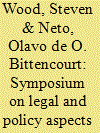

|
|
|
|
|
| Publication |
2014.
|
| Summary/Abstract |
In the spirit of the diversity of the many nations currently engaging in exploratory, scientific and technical endeavors in outer space, representatives from all BRICS countries and their respective or potential European collaborators gathered for the "Symposium on Legal and Policy Aspects of Space Cooperation between Europe and the BRICS Countries". Held on 16 May 2013, the Symposium took place in the Netherlands at Leiden University, and was jointly organized by the International Institute of Air and Space Law of Leiden Law School and the Department of Latin American Studies of Leiden University's Faculty of Humanities
|
|
|
|
|
|
|
|
|
|
|
|
|
|
|
|
| 16 |
ID:
132722


|
|
|
|
|
| Publication |
2014.
|
| Summary/Abstract |
In order to justify high expenditure during this period of financial crisis, Space Agencies have attempted to increase the returns on their investments in Space missions by encouraging the commercial use of advanced technologies. The development of a technology transfer process from Space to Earth not only benefits the Aerospace industry but also the network of national companies. Technology transfer has been shown to stimulate innovation in business and commerce, support economic growth and provide a return on public investment in research and development (R&D). The aim of this paper is to systematically review the Space technology transfer literature and to suggest directions for future research. The range of research and studies in the literature on this topic requires a systematic review to summarize the results in an unbiased and balanced manner and to interpret these in a way that highlights the research gaps. This article presents an overview of the dominant thinking (explicit in selected articles from 1995 to present), indicating the problems of analysis, research gaps and a future research program.
|
|
|
|
|
|
|
|
|
|
|
|
|
|
|
|
| 17 |
ID:
101219
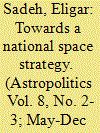

|
|
|
| 18 |
ID:
132562
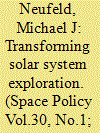

|
|
|
|
|
| Publication |
2014.
|
| Summary/Abstract |
The Discovery Program is a rarity in the history of NASA solar system exploration: a reform program that has survived and continued to be influential. This article examines its emergence between 1989 and 1993, largely as the result of the intervention of two people: Stamatios "Tom" Krimigis of the Johns Hopkins University Applied Physics Laboratory (APL), and Wesley Huntress of NASA, who was Division Director of Solar System Exploration 1990-92 and the Associate Administrator for Space Science 1992-98. Krimigis drew on his leadership experience in the space physics community and his knowledge of its Explorer program to propose that it was possible to create new missions to the inner solar system for a fraction of the existing costs. He continued to push that idea for the next two years, but it took the influence of Huntress at NASA Headquarters to push it on to the agenda. Huntress explicitly decided to use APL to force change on the Jet Propulsion Laboratory and the planetary science community. He succeeded in moving the JPL Mars Pathfinder and APL Near Earth Asteroid Rendezvous (NEAR) mission proposals forward as the opening missions for Discovery. But it took Krimigis's political skill and access to Sen. Barbara Mikulski in 1993 to get the NEAR into the NASA budget, thereby likely ensuring that Discovery would not become another one-mission program
|
|
|
|
|
|
|
|
|
|
|
|
|
|
|
|
| 19 |
ID:
101227
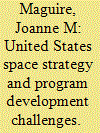

|
|
|
|
|
| Publication |
2010.
|
| Summary/Abstract |
The world has been utterly transformed by space technology and space systems. In the 21st century, we rely on the incredible capabilities they provide us for tasks from the most mundane to the most profound. Every moment of every day, even though we are unaware of its presence, we are engulfed in an invisible digital torrent that streams in two directions, from space to Earth and back again. This ever-present inundation links us to the satellites that serve us, connecting our world in a way that defies imagination. But our nation is not guided by a grand, overarching space strategy. This paper outlines the reason such a strategy is mandatory, the obstacles we must overcome, and the factors we must include in our strategy.
|
|
|
|
|
|
|
|
|
|
|
|
|
|
|
|
| 20 |
ID:
132568
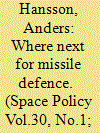

|
|
|
|
|
| Publication |
2014.
|
| Summary/Abstract |
The royal united services institution (RUSI) held its 14th missile defence conference in London, 12-13 June 2013. The conference took place 30 years after president Reagan's announcement of a program to make nuclear weapons important and obsolete in fact what was assumed to have been a routine defence speech triggered a new engagement with the then USSR. President Regan did not mention space bases laser and particle beams. The press give little attention to these aspects at the time.
|
|
|
|
|
|
|
|
|
|
|
|
|
|
|
|
|
|
|
|
|